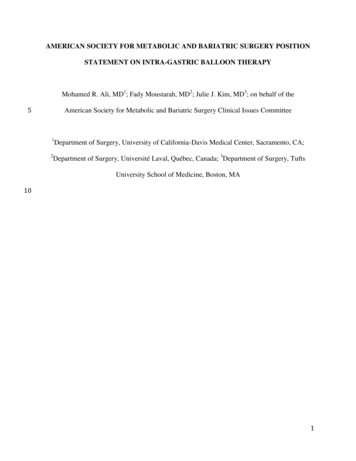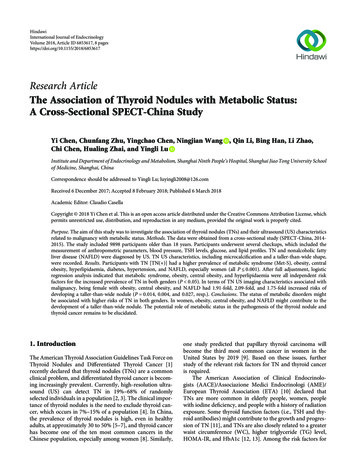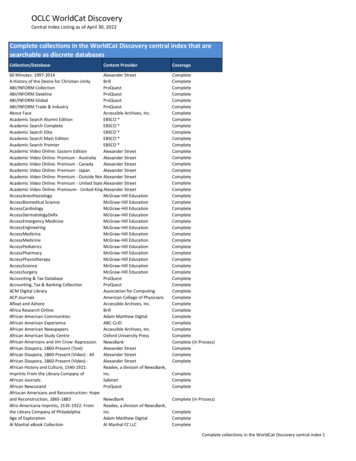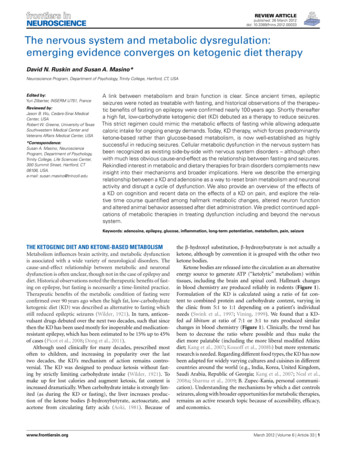
Transcription
AMERICAN SOCIETY FOR METABOLIC AND BARIATRIC SURGERY POSITIONSTATEMENT ON INTRA-GASTRIC BALLOON THERAPYMohamed R. Ali, MD1; Fady Moustarah, MD2; Julie J. Kim, MD3; on behalf of the5American Society for Metabolic and Bariatric Surgery Clinical Issues Committee12Department of Surgery, University of California-Davis Medical Center, Sacramento, CA;Department of Surgery, Université Laval, Québec, Canada; 3Department of Surgery, TuftsUniversity School of Medicine, Boston, MA101
The American Society for Metabolic and Bariatric Surgery (ASMBS) has issued thefollowing position statement in response to numerous inquiries made to the Society by patients,15physicians, society members, hospitals, health insurance payers, the media, and others regardingthe role of intra-gastric balloons in the treatment of obesity. The intent of issuing such astatement is to provide an overview of the available evidence regarding the impact ofendoscopically placed intra-gastric balloon technology in the current management of obesity andrelated diseases. The statement is not intended as, and should not be construed as, stating or20establishing a local, regional, or national standard of care.The IssueThe continuing rise of obesity rates worldwide and the lack of effective medical25treatments for this disease have propelled interventional weight loss therapies to the forefront ofthe battle against this epidemic. A large body of high quality clinical evidence identifies bariatricand metabolic surgery as the most effective method to achieve and maintain substantial weightloss for individuals with clinically severe obesity. There are, however, those individuals who,despite meeting medical necessity for bariatric surgery, may choose not to have surgery or may30not qualify as surgical candidates based on existing criteria or surgeon assessment. Examples ofthe latter include individuals with obesity-related comorbidities whose body mass index (BMI)falls below presently established eligibility criteria that qualify patients for bariatric surgeryand/or patients who are deemed to be at high surgical risk, whether that is due to severe obesitywith excessively high BMI or poor general health status. Other patients, such as those belonging35to specific age groups or those seeking to optimize health as a bridge to a non-obesity therapy2
(organ transplant, knee or hip replacement, e.g.,) may wish to lose weight using options otherthan surgery. Effective options for these patient groups are limited. To date, pharmacotherapyand medically supervised diet programs have variable and modest efficacy for weight loss, andthey are generally ineffective for long-term weight loss maintenance and co-morbidity40reduction.1-3 Thus, there is a need for effective bariatric and metabolic interventions that canselectively serve specific groups of obese patients by offering alternatives to surgery orproviding adjunctive therapy.One management strategy that has been proposed to fill this treatment gap is intra-gastric45balloon therapy. With three decades of innovation in this field, clinical experience with intragastric balloons has emerged. The U.S. Food and Drug Administration (FDA) mandated trialshave helped to address intra-gastric balloon outcomes in rigorous clinical investigation.Furthermore, the physiologic mechanisms by which intra-gastric balloons achieve weight lossare not completely understood. The prevailing notion is that weight loss results from increased50satiety and a delay in gastric emptying.4,5 Currently, there are two balloon therapy systems thatare FDA approved: The ReShapeTM Integrated Dual Balloon System (ReShape Medical, Inc., SanClemente, CA) and the ORBERATM Intragastric Balloon System (Apollo Endosurgery, Inc.,Austin, TX).6,755Description of the Technology and its ApplicationThe use of intra-gastric balloons to treat obesity is not recent. The original description ofintra-gastric balloon therapy for weight loss has been credited to Nieben in 1982.8 Over the next3
decade, a few randomized controlled trials were performed to evaluate the clinical applicability,60safety, and efficacy of this technology.9-11 Recent innovation in balloon materials and methodsfor delivery and extraction, combined with clinical need has renewed interest in the intra-gastricballoon as a weight loss treatment.Intra-gastric balloons are generally placed endoscopically. Procedures have been65performed under conscious sedation or general anesthesia with success.12,13 A number of papers,which cite technical data, indicate that procedure time for insertion and filling of the balloon isusually about 15 minutes.13,14 Balloon insertion and extraction are associated with relatively fewoperative complications.12-14 These will be addressed separately in the adverse events section ofthis document.70Available clinical data and manufacturer recommendations indicate six months to be thecurrent standard duration of therapy from insertion to removal. However, balloon extraction isoften followed by weight regain, and studies investigated the weight loss effect of long-termsingle15 or multiple sequential balloon insertions.16 Other balloons have been designed to remain75implanted for 12 months and allow adjustment in fluid volume to address patient symptoms(deflation) and weight loss plateaus (inflation).17Regardless of the type of balloon and duration of use, there is often a need for aggressivesymptom control in the early period after balloon insertion with anti-nausea medications and80proton pump inhibitors. While many patients can experience early nausea and epigastric pain,these symptoms seem to persist beyond the first week only in a minority.13,14,184
Safety (adverse events including voluntary removals)85Initial balloons in the early 1980s were filled with air, but complications quickly aroseincluding insufficient weight loss, and were most commonly related to patient intolerance due tonausea, as well as difficulties with deflation and inflation of the balloon. Occasionally,spontaneous deflation and passage of the balloon into the small bowel would occur, causingbowel obstruction. Aside from unplanned deflations and obstructions, gastric ulcers with90gastrointestinal hemorrhage and gastric perforation have been reported.19 Consequently, an“expert” panel convened and proposed ideal characteristics for an intra-gastric balloon toenhance safety.20 Panel recommendations included that the balloon be liquid filled and enhancedwith a methylene blue indicator that can be absorbed and excreted by the patient in the event ofballoon leakage, prompting timely detection and endoscopic intervention for removal. Since95then, many new fluid-filled and modified air-filled balloons have been developed and employedworldwide.14,21,22Despite modifications to the technology, adverse events, including non-efficacy,occasionally occur. This warrants consideration and discussion with patients who are considering100the intra-gastric balloon as a stand-alone weight loss intervention or, in select situations, asadjunctive therapy to optimize readiness for bariatric surgery despite the lack of clear evidence tosupport such practice at this time. First, some historic sham-controlled studies failed todemonstrate superiority of intra-gastric balloon interventions when compared to lifestylemodification with diet, exercise and follow-up.9,23-26 Second, early complications of clinical5
105significance to patients include epigastric pain, nausea, and vomiting. While these symptoms aregenerally transient, they may be difficult to control even with pharmacotherapy and place somepatients at risk of dehydration, resulting in the voluntary removal of the balloon in up to 7% ofcases.18,26110A review of 3443 patients documented early removal of the Bioenterics Intra-gastricBalloon (BIB) to occur at a rate of 4.2%, primarily for abdominal pain, obstruction in thegastrointestinal tract, nausea and vomiting, gastric ulceration, gastric perforation, dehydration,voluntary removal, and deflation of the balloon with or without displacement.18 Spontaneousballoon deflation has been reported to occur at variable frequencies (3-23%).26 These can be115detected early to minimize complications either by ultrasonography at regular intervals or bygreen discoloration of the urine in balloons (such as the BIB) with the methylene blue indicator,which is absorbed upon leakage and excreted into the urine. Most deflated balloons are passedspontaneously, but obstructions have been reported, particularly in patients with previousabdominal surgery. Rarely, gastroduodenal ulcers, Mallory-Weiss tears, and esophagitis have120also been reported after balloon placement despite aggressive proton pump inhibitor therapy.26,27It is generally recommended that if used for weight loss, intra-gastric balloons should beremoved within 6 months to reduce the risk of deflation and complications.27 Although severecomplications reported in the literature were infrequent, they did include bowel obstructionsrequiring surgery, gastric perforations, and death.18 In a review of BIB, Dumonceau et al125reported a treatment-related mortality rate of 0.07% due to post-insertion broncho-aspiration andgastric perforation in patients with previous fundoplication, highlighting the importance ofpatient selection.26 Generally cited absolute contraindications for intra-gastric balloon use6
include previous gastric surgery, hiatal hernia 5 cm, a coagulation disorder, a potential bleedinglesion of the upper gastrointestinal tract, pregnancy or desire to become pregnant, breast-feeding,130alcoholism or drug addiction, severe liver disease, or any contra-indication to endoscopy.13,14,26,28Relative contraindications include previous abdominal surgery, hiatal hernia, esophagitis,Crohn’s disease, non-steroidal anti-inflammatory drug use, or uncontrolled psychiatricdisorders.13,14,26,28135One final point regarding the adverse event profile of intra-gastric balloon technologyrequires separate and special mention. Because all balloons require removal, adverse events canresult from patients getting lost to follow-up. Loss to follow-up increases the likelihood ofballoon leakage and passage into the intestine, where obstruction may occur. The risk ofpremature passage into the intestine increases if a balloon is left in the stomach longer than six140months.19 Thus, selection of patients committed to follow-up, prompt removal by six monthsfrom the time of insertion of most balloons are recommended to enhance the safety profile andutilization of available intra-gastric balloon technologies.Efficacy145The efficacy of an intra-gastric balloon intervention has at least two components: thebehavioral (diet and lifestyle) effect and the balloon effect. To isolate the balloon effect it isimportant to look at controlled studies. Historically, some evidence exists to suggest that weightloss observed in patients receiving balloon therapy is comparable to weight loss that can be150achieved by dietary manipulation alone.9,23-25 In recent approval of two intra-gastric balloon7
systems, the FDA cited pivotal trial evidence that greater weight loss can be accomplished withdevice use than with diet alone and that this difference reached statistical significance.6,7A review in 2008 showed only one of three sham-controlled trials found a significantly155higher weight loss with the BIB compared to the sham procedure plus exhaustive follow-up.26Mathus-Vliegen et al randomized 43 patients with morbid obesity a mean baseline BMI of 43.3kg/m2 into a sham group and a balloon-treated group for three months.24 Based on an intention totreat, weight loss was not statistically different between groups at 3 months. After the first 3months, the sham group underwent balloon insertion, and both groups were followed for one160year. Although an independent benefit of balloon treatment beyond that of diet, exercise, andbehavioral therapy could not be demonstrated at 3 months, the observed mean percentage of totalbody weight loss (%TBWL) at one year was approximately 17%, and 75% of patients were ableto achieve 10% TBWL.24165Genco et al, on the other hand, reported an effect of the balloon in inducing weight lossbeyond that obtained with sham treatment.28 In a randomized controlled study of 32 patients witha baseline BMI of 43.3 kg/m2, a 34% excess weight loss (EWL) was observed in the treatmentgroup when compared to sham (p 0.001).28 In 2008, the same group also published results of acase matched series where a cohort of 130 patients receiving intra-gastric balloon therapy was170compared to a historical cohort of 130 matched patients that received diet therapy alone.29 Again,they demonstrated that the %EWL of 33.9% in the balloon group was statistically better than the24.3% EWL observed in the historical, non-randomized control group at six months of treatmenttime.8
175A smaller randomized trial primarily focused on assessing the efficacy of BIB inimproving liver histology in patients with nonalcoholic steatohepatitis (NASH) showedimprovement in NASH with the balloon. The study did not report TBWL or EWL in a sample ofpatients with BMI 27kg/m2 randomized to balloon plus step 1 American Heart Association dietversus diet alone.25 They did not note a significant difference in mean BMI decrease between the180groups indicating a weight-independent improvement for NASH patients.Ponce et al conducted a randomized controlled trial utilizing the ReShape Duo IntegratedDual Balloon System (DUO) diet and exercise in comparison to sham endoscopy diet andexercise.14 Patients with a mean BMI of 35 kg/m2 were enrolled and followed for 24 weeks.185After randomization, the study included a large sample of 187 treatment subjects and 139 controlsubjects. At six months, %EWL was significantly higher at 25.1% in the treatment group whencompared to the 11.3% EWL observed in the control group. For the 167 patients (out of 187)who completed DUO balloon therapy, %EWL was even higher at 27.9%. This was more thandouble that observed in the diet and exercise group. Reported mean TBWL was 7.2 kg or 7.6%190TBWL (i.e. 10%).14The estimate of intra-gastric balloon effectiveness at removal (6 months post-insertion)comes from a number of additional retrospective and prospective case series.30-33 The reviewedstudies varied in reporting of outcomes, and the most commonly reported anthropometric195measurement was %EWL. On average, %EWL was approximately 34.5% (range 7% to 56%).9
Overall, the data suggest that the intra-gastric balloon is an effective tool for weight loss.Most of its effect has been observed in the first three months after insertion, during whichpatients usually lose more than 12 kg. At removal, or 6 months post-insertion, studies, including200randomized controlled trials, suggest that the expected %EWL is about 24%. Lopez-Nava et alreported that TBWL is higher in patients with higher starting weight but that %EWL is greater inwomen and in the less obese.34 On the other hand, Peker et al observed that weight loss plateauedat three months and that BIB therapy was more effective in those with a BMI 40 kg/m2 than inthose with BMI between 30 – 39 kg/m2.30205Some studies examined the sustainability of weight loss beyond the time of balloonremoval. In a randomized sham-controlled study with crossover at three months, Genco et alshowed that the group that had the balloon inserted for three months continued to lose weight ata greater rate in the three months following balloon removal compared to the group that started210out without a balloon for three months and observed for weight loss.28 The authors hypothesizedthe persistence of a device effect on alimentary behavior even after the balloon was removed. Inanother publication, the same group followed patients for six months after balloon removal andfound that, while weight regain was observed, %EWL was still 25% at 12 months.35 Inaddition, when a second balloon treatment was offered after a one month break following215removal of the first balloon, patients achieved 52% EWL at one year, which was higher than thatobserved when only one balloon treatment period was offered. In a review, Gaur et al similarlyreported that 52% of the weight lost during balloon therapy was sustained 12 months afterballoon removal.1910
220Kotzampassi et al, who described five-year outcomes in a retrospective series of 500patients, reported longer post-balloon treatment follow-up.36 Only 395 patients were included inthe analysis; however, as 17% of patients who did not attain 20% EWL after BIB treatmentwere excluded. At two years of follow-up, 17.1% EWL was noted in 352 patients. This wasdown from 27.7% EWL observed at one year after balloon removal in the same patient cohort.225This study reported that 68% of the weight lost during balloon therapy was sustained 12 monthsafter removal in responders (patients who lost 20% EWL) who were not lost to follow-up.36 Atfive years, 12.97% EWL was maintained in patients available for follow-up.The most contemporary evidence for efficacy comes from two different FDA trials on230intra-gastric balloon technology. Both balloon systems have been recently approved for clinicaluse in the United States: ORBERA and ReShape . The pivotal study of ORBERA , knownas IB-005, was a multicenter, prospective, randomized, non-blinded comparative study of 448patients. The pivotal trial for ReShape , known as REDUCE, was a prospective, shamcontrolled, double-blinded, randomized multicenter clinical study of 330 patients. Both balloon235technologies demonstrated greater weight loss that reached statistical significance whencompared to diet interventions in their study population, as detailed in the FDA documents.6,7Summary and Recommendations2401. Level 1 data regarding the clinical utility, efficacy, and safety of intra-gastric balloontherapy for obesity are derived from randomized clinical studies.11
2. Implantation of intra-gastric balloons can result in notable weight loss during treatment.A few studies, representing lower level evidence, have suggested that the weight losseffect can be maintained after balloon retrieval for some finite time into the future.2453. While utilization of intra-gastric balloons results in notable weight loss, separating theeffect of the balloon alone from those of supervised diet and lifestyle changes may bechallenging. Of note, the recent FDA pivotal trials demonstrate a benefit to balloon usecompared to diet alone in their study populations. In general, any obesity treatment,including intra-gastric balloon therapy, would benefit from a multi-disciplinary team250skilled and experienced in providing in-person medical, nutritional, psychological andexercise counseling.4. The safety profiles for intra-gastric balloons indicate a safe intervention with rare seriouscomplications. Early postoperative tolerance challenges can be significant but can becontrolled with pharmacotherapy in the majority of patients, thereby minimizing255voluntary balloon removals. These early symptoms should be discussed with the patientprior to the procedure.5. Although prolonged duration of balloon therapy and sequential treatments with multipleballoons has been studied, awareness and adherence to absolute and relativecontraindications of use and timely removal optimize device safety. Based on current260evidence, balloon therapy is FDA approved as an endoscopic, temporary (maximum 6months) tool for the management of obesity. Further review will evaluate the impact thatdiet, lifestyle changes and pharmacotherapy have during and after balloon removal.12
6. The ability to perform appropriate follow-up is essential when intra-gastric balloons areused for weight loss to enhance their safety and avoid complications related to265spontaneous deflation and bowel obstruction.13
References2701.Bour ES. Evidence supporting the need for bariatric surgery to address the obesityepidemic in the United States. Curr Sports Med Rep 2015;14(2):100-3.2.Shadid S, Jakob RC, Jensen MD. Long-term, sustained, lifestyle-induced weight lossin severe obesity: the GET-ReAL program. Endocr Pract 2015;21(4):330-8.3.275Shukla AP, Buniak WI, Aronne LJ. Treatment of obesity in 2015. J CardiopulmRehabil Prev 2015;35(2):81-92.4.Sallet JA, Marchesini JB, Paiva DS, et al. Brazilian multicenter study of theintragastric balloon. Obes Surg 2004;14(7):991-8.5.Hodson RM, Zacharoulis D, Goutzamani E, Slee P, Wood S, Wedgwood KR.Management of obesity with the new intragastric balloon. Obes Surg 2001;11(3):327-28029.6.U.S. Food and Drug Administration. Summary of Safety and Effectiveness Data(SSED). ORBERA Intragastric Balloon System - P140008. Available at:http://www.accessdata.fda.gov/cdrh docs/pdf14/P140008b.pdf. Last accessedDecember 16, 2015.2857.United States Food and Drug Administration. Summary of Safety and EffectivenessData (SSED). ReShape Integrated Dual Balloon System – P140012. Available at:http://www.accessdata.fda.gov/cdrh docs/pdf14/P140012b.pdf. Last accessedDecember 16, 2015.8.290Nieben OG, Harboe H. Intragastric balloon as an artificial bezoar for treatment ofobesity. Lancet 1982;1(8265):198-9.14
9.Benjamin SB, Maher KA, Cattau EL, Jr., et al. Double-blind controlled trial of theGarren-Edwards gastric bubble: an adjunctive treatment for exogenous obesity.Gastroenterology 1988;95(3):581-8.10.295Meshkinpour H, Hsu D, Farivar S. Effect of gastric bubble as a weight reductiondevice: a controlled, crossover study. Gastroenterology 1988;95(3):589-92.11.Hogan RB, Johnston JH, Long BW, et al. A double-blind, randomized, shamcontrolled trial of the gastric bubble for obesity. Gastrointest Endosc 1989;35(5):3815.12.300Genco A, López-Nava G, Wahlen C, et al. Multi-centre European experience withintragastric balloon in overweight populations: 13 years of experience. Obes Surg2013;23(4):515-21.13.De Castro ML, Morales MJ, Del Campo V, et al. Efficacy, safety, and tolerance oftwo types of intragastric balloons placed in obese subjects: a double-blindcomparative study. Obes Surg 2010;20(12):1642-6.30514.Ponce J, Woodman G, Swain J, et al; REDUCE Pivotal Trial Investigators. TheREDUCE pivotal trial: a prospective, randomized controlled pivotal trial of a dualintragastric balloon for the treatment of obesity. Surg Obes Relat Dis 2015;11(4):87481.15.310Genco A, Maselli R, Frangella F, et al. Intragastric balloon for obesity treatment:results of a multicentric evaluation for balloons left in place for more than 6 months.Surg Endosc 2015;29(8):2339-43.16.Alfredo G, Roberta M, Massimiliano C, Michele L, Nicola B, Adriano R. Long-termmultiple intragastric balloon treatment--a new strategy to treat morbid obese patients15
refusing surgery: prospective 6-year follow-up study. Surg Obes Relat Dis3152014;10(2):307-11.17.Brooks J, Srivastava ED, Mathus-Vliegen EM. One-year adjustable intragastricballoons: results in 73 consecutive patients in the U.K. Obes Surg 2014;24(5):813-9.18.Imaz I, Martinez-Cervell C, Garcia-Alvarez EE, Sendra-Gutiérrez JM, GonzálezEnríquez J. Safety and effectiveness of the intragastric balloon for obesity. A meta-320analysis. Obes Surg 2008;18(7):841-6.19.Gaur S, Levy S, Mathus-Vliegen L, Chuttani R. Balancing risk and reward: a criticalreview of the intragastric balloon for weight loss. Gastrointest Endosc2015;81(6):1330-6.20.325Schapiro M, Benjamin S, Blackburn G, et al. Obesity and the gastric balloon: acomprehensive workshop. Tarpon Springs, Florida, March 19-21, 1987. GastrointestEndosc 1987;33(4):323-7.21.Doldi SB, Micheletto G, Di Prisco F, Zappa MA, Lattuada E, Reitano M. Intragastricballoon in obese patients. Obes Surg 2000;10(6):578-81.22.330Machytka E, Klvana P, Kornbluth A, et al. Adjustable intragastric balloons: a 12month pilot trial in endoscopic weight loss management. Obes Surg2011;21(10):1499-507.23.Stoltenberg PH, Piziak VK, Dietscher JE. Intra-gastric balloon therapy of obesity: arandomized double-blind trial. Gastroenterology 1987;92(5):1655.24.335Mathus-Vliegen EM, Tytgat GN. Intragastric balloon for treatment-resistant obesity:safety, tolerance, and efficacy of 1-year balloon treatment followed by a 1-yearballoon-free follow-up. Gastrointest Endosc 2005;61(1):19-27.16
25.Lee YM, Low HC, Lim LG, et al. Intragastric balloon significantly improvesnonalcoholic fatty liver disease activity score in obese patients with nonalcoholicsteatohepatitis: a pilot study. Gastrointest Endosc 2012;76(4):756-60.34026.Dumonceau JM. Evidence-based review of the Bioenterics intragastric balloon forweight loss. Obes Surg 2008;18(12):1611-7.27.Yap Kannan R, Nutt MR. Are intra-gastric adjustable balloon system safe? A caseseries. Int J Surg Case Rep 2013;4(10):936-8.28.345Genco A, Cipriano M, Bacci V, et al. BioEnterics Intragastric Balloon (BIB): a shortterm, double-blind, randomised, controlled, crossover study on weight reduction inmorbidly obese patients. Int J Obes (Lond) 2006;30(1):129-33.29.Genco A, Balducci S, Bacci V, et al. Intragastric balloon or diet alone? Aretrospective evaluation. Obes Surg 2008;18(8):989-92.30.350Peker Y, Durak E, Ozgurbuz U. Intragastric balloon treatment for obesity:prospective single-center study findings. Obesity facts. 2010;3(2):105-108.31.Göttig S, Weiner RA, Daskalakis M. Preoperative weight reduction using theintragastric balloon. Obes Facts 2009;2 Suppl 1:20-3.32.Ganesh R, Rao AD, Baladas HG, Leese T. The Bioenteric Intragastric Balloon (BIB)as a treatment for obesity: poor results in Asian patients. Singapore Med J3552007;48(3):227-31.33.Melissas J, Mouzas J, Filis D, et al. The intragastric balloon - smoothing the path tobariatric surgery. Obes Surg 2006;16(7):897-902.17
34.Lopez-Nava G, Bautista-Castaño I, Jimenez-Baños A, Fernandez-Corbelle JP. DualIntragastric Balloon: Single ambulatory center Spanish experience with 60 patients in360endoscopic weight loss management. Obes Surg 2015;25(12):2263-7.35.Genco A, Cipriano M, Bacci V, et al. Intragastric balloon followed by diet vsintragastric balloon followed by another balloon: a prospective study on 100 patients.Obes Surg 2010;20(11):1496-500.36.365Kotzampassi K, Grosomanidis V, Papakostas P, Penna S, Eleftheriadis E. 500intragastric balloons: what happens 5 years thereafter? Obes Surg 2012;22(6):896903.18
25 treatments for this disease have propelled interventional weight loss therapies to the forefront of the battle against this epidemic. A large body of high quality clinical evidence identifies bariatric and metabolic surgery as the most effective method to achieve and maintain substantial weight











